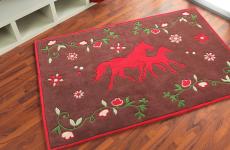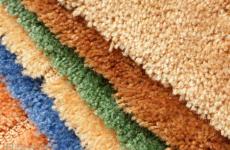What color wallpaper to choose for different rooms of the house? Recommendations and tips: how to choose a wallpaper for your home interior How to choose a wallpaper if you like many
To decorate the interior beautifully, it is necessary to think over a harmonious combination of colors of walls and furniture. Such an important detail can fill a room with light, visually expand, narrow or lengthen the space, create a cozy atmosphere, and place the necessary accents. Compliance with simple rules and tips on how to choose wallpaper for furniture will make the design truly unique and unique!
Types of wallpaper
There are several basic options for wallpaper. Information about their characteristics, properties and assortment will help you make a choice in favor of the required material.
Vinyl wallpapers
This is one of the most popular wall coverings. The basis of the composition is a special paper or non-woven coated with polyvinyl chloride. The advantages of this choice include a reasonable price and a wide range of colors. By cons - air tightness.

Non-woven wallpaper
Many experts consider them to be the best choice for any room. Such wallpapers are characterized by high moisture resistance, air permeability and environmental friendliness. The disadvantages include a small selection of patterns and colors, which, however, is not a problem for the classic, Scandinavian, minimalist and constructive styles, which are famous for their brevity and consistency.

Liquid wallpaper
They are purchased as a powder that is diluted with water upon application. A great solution for creative people. You can experiment with shades, and fix the desired one with a protective varnish. This will help prevent paint from being washed off.

Paper wallpaper
Environmental friendliness, air permeability, loyal price - these are the main positive criteria for paper wallpapers. The negative aspects include the lack of moisture resistance and rapid fading.

Fabric wallpaper
A spectacular colorful finish that will easily fit into the design of any room. The only downside is the lack of moisture resistance, which is especially important for the kitchen and bathroom.

Choosing the color of wallpaper for furniture
The main rule for creating a bright color scheme in a room is the harmony of shades or their contrast. In the first case, the space will look light, delicate and gentle, in the second - extravagant, bright and original. We have compiled a small list of interesting tips for choosing colors for different furniture:

1. For dark furniture, beige, white, lemon and pistachio (light green) wallpapers are suitable;
2. The following colors will be ideally combined with white furniture: pink, turquoise, coffee, green, blue and yellow. Wallpaper with a golden pattern or geometric ornament can also serve as a beautiful background;
3. For furniture in black, you need to choose a burgundy, gray, beige or silver finish;
4. Gray furniture can be easily shaded with blue, green, pink, white and yellow tones;
5. The correct decor for brown furniture is beige, olive and white wallpaper;
6. Suitable range for beige furniture: green, light red, blue and white.

Do not forget about the emphasis rule as well. This means that the overall environment will look much more sophisticated if the furniture and walls do not merge together, but are not equally colorful.
For example, against the background of bright walls, modest furniture will look great, against the background of extravagant furniture - simple plain wallpaper.

It is very important to be able to use the little tricks of specialists that will help make all interior dreams come true. You can mention the following secrets for choosing the color / tone of wallpaper for furniture:
Wallpaper can serve as a background for beautiful furniture, but should not be lost against its background;
- A surface with a variegated pattern can distract from old or unremarkable furniture;
- If you cannot find the desired wallpaper color in the proposed range, you should buy paintable wallpaper and create your own unique shade yourself;

To emphasize stylish furniture, you need to give preference to beige and yellow wallpaper;
- Additional light sources (LED lamps) will help the surfaces look more saturated or vice versa - muted (optional);
- Light and "airy" wallpaper will skillfully remove the boundaries between furniture and space;
- Furniture with gold inserts looks luxurious against a background of cream or sand color, wood - against a white background, metal - against a light blue background.


We select wallpaper for furniture in different rooms
It's no secret that colors can influence the emotional state and mood of a person. Each room has its own harmonious range of colors.
Wallpaper for furniture in the bedroom
It is necessary to consider the design of the bedroom. If the furniture, its arrangement and color palette are made in the style of avant-garde, art deco, modern or minimalism, then wallpaper in light shades will be an excellent choice, which will serve as a wonderful element of relaxation.
In the case of original (unusual shapes) or natural (stone or wood) furniture, it is worth using neutral wallpaper with colorful inserts in the form of mosaics or geometric shapes. This contrast will create a creative and inspiring atmosphere.









Wallpaper for furniture in the living room
Bulky furniture is most often present in the hall. You can dilute it with combined wallpaper, which can make one part of the room calmer and more comfortable, and the other rich and juicy.
If the furniture in the living room is made in light shades, you can choose a beige wall covering with bright inserts or colorful wallpaper with light splashes. If it's a classic style, it's best to stick with neutral tones.










Wallpaper for furniture in the children's room
In a room for small children, there is most often furniture of interesting designs, unusual beds and bright shelves. This is an ideal place for photo wallpapers that will add to the atmosphere of joy, childhood and emotions.
A calm child will be comfortable in a light room (beige, peach, lemon wallpaper), and an active one in a colorful one (wallpaper with cartoon characters).
So that the space does not seem too saturated and cluttered, you can make one wall (which is located behind the bed) neutral, and the rest - brighter.









Wallpaper for furniture in the kitchen
Nowadays, hardly anyone buys separate furniture for the kitchen. Built-in projects are becoming more and more popular. They range from dark gray to light yellow.
In this case, it is worth remembering that wallpaper can look organically, the color of which will be chosen one or two shades lighter than dark furniture and one or two shades brighter than light furniture. You can also make furniture and walls in the same tone. It looks practical and beautiful in the kitchen.










Wallpaper for bathroom furniture
Do not forget that wallpaper should not only harmoniously emphasize the aesthetics of the room, but also meet such important criteria as moisture resistance and air permeability. The ideal solution for a bathroom with any furniture is pastel colors. They are always relevant, especially in the bedroom and bathroom.
Since ancient times, the dwellings of noble people have been decorated with wallpaper. The nobility of Europe upholstered the walls and ceilings with fabric. Then the name appeared. Popularity for paper wallpapers came from China and Japan in the century before last, where they have been traditional since antiquity. In the thirties of the twentieth century, polymer and other wallpapers were created. Now, it is not difficult to buy high quality building materials for any budget and design.
Today wallpapers are available and present in every home. They decorate, create coziness, ensure the hygiene of the home. They can significantly change the appearance of a room, lighting, absorb unnecessary noises and sounds.

The production of paper, textile and vinyl wallpapers is widespread, which are smooth and embossed in type, and embossed in appearance, profile, velor, metallized, photo wallpaper and others.

Wallpaper color
Wallpaper can be of a single color and decorated with drawings or photographic images (photo wallpaper). There are some that can be washed or painted. The modern market offers a huge assortment of different wallpapers. How to figure it out and choose the right one?
The best examples of paper wallpaper last for ten years (the period of interior renovation), but they do not withstand high humidity and absorb odors, so they are not used in bathrooms and toilet rooms, as well as in the kitchen.
It is practical to cover such rooms with vinyl or washable wallpaper. They are attractive, have high strength, elasticity, lightfastness, waterproofness. When gluing, it must be borne in mind that, when dry, this wallpaper shrinks. They do not withstand temperature extremes.

Those who prefer textile wallpaper should know that it is fabric, fibers, laminated onto paper. Warmth and comfort emanate from them, they have good thermal insulation, absorb sounds, and are also protected from fire. When gluing, this wallpaper does not need to be customized according to the pattern.

There are colorless wallpapers that can be painted or turned into a work of art. They are durable. Usually acrylic, latex or water dispersion paints are used. The applied paint can be renewed, which is convenient for repairs.

How to buy wallpaper correctly
Before buying wallpaper, you need to measure the room and calculate the required number of rolls. You need to buy with a small margin, from one batch, having written down the data about the product.

Wallpaper of increased thickness will cover the flaws in the surface of the wall, but for high-quality work, it must be prepared.

The wall must be dry. This can be checked with a plastic wrap by sticking it to the wall with tape for several hours. If condensation drops form underneath, dry the room.

The surface of the wall must be strong enough. You need to make a scratch and then apply pressure to it. In this case, cracks should not form. All sections of the wall need to be aligned. If necessary, putty, plaster, primer.

For each class of wallpaper, a suitable adhesive is required. It is applied with a roller and brush. When working, use a plumb line. They usually start from the window. When approaching switches or sockets, you must de-energize them. Then remove the outer cover, glue on top of the next sheet, cut out a hole with a knife and screw the cover into place.












Swelling may occur in drafts. It is necessary to cut this place with a cross, glue it carefully and press it, smoothing the unsticked area. Wallpaper can flake off in poorly prepared areas.

Here you will have to do what should have been done initially - thorough surface preparation. When dry, a gap may form between the strips of wallpaper, which can be sealed with commercially available tapes or made by yourself.

Photo of the best wallpaper






































Today, there are many interesting options for wall covering. To answer the question of how to choose wallpaper for an apartment, you need to learn to distinguish them according to aesthetic data, texture and style.
The main types of wallpaper
The choice of wall covering should be treated competently and responsibly. Only taking into account the condition of the walls of the room, the practicality of the wallpaper, their characteristics, you can be sure that the renovation of the apartment will delight the eyes of the owners and guests for many years. There are several main types of wallpaper.
Paper wallpaper
A classic choice proven by millions of people. The main subspecies of paper wallpaper are simplex (one thin layer) and duplex (two layers, one of which creates additional density and lightfastness). The main advantages of this option are high air transmission, environmental friendliness, a variety of colors, and a reasonable price. The disadvantages include low moisture resistance.


Wallpaper
They consist of several separate or one large fragment of a photograph. These can be both portrait images and landscape ones. Ease of gluing, creative look and low price are the main trump cards of photowall-paper. Minus - low strength (compared to other types of wallpaper).



Vinyl wallpapers
This is one of the most popular options for decorating the walls of an apartment. The main composition of vinyl wallpaper is non-woven and polyvinyl chloride. In structure, they can be foamed (with a rough texture or shiny elements), silk-screen (capable of slightly modifying the original shade depending on the light) and glossy. Vinyl wallpaper is wear-resistant, moisture-resistant, and also completely unpretentious in maintenance. The small disadvantages include the difficulty of gluing and low air permeability.



Non-woven wallpaper
It is them that many designers advise to choose for the wall covering of an apartment. Embossed patterns and expressive ornaments will decorate any corner, and such important properties as hypoallergenicity, wear resistance, breathability and ease of maintenance can guarantee a successful repair.


Liquid wallpaper
An interesting mixture in the form of a powder, which, when combined with water, turns into the most unusual shades. You can easily experiment with them by choosing the desired color. Fixation takes place with a special protective varnish.


Experts who have been studying all the details of wall decoration not only in theory, but also in their own practice for many years, say that it is necessary to take into account the individual characteristics of the room, and then any home can become comfortable and practical. The following techniques will help to visually improve the room with the help of wallpaper:
1. Wallpaper with a bright pattern or geometric patterns can narrow a room that is too wide.
2. To expand a cramped room, you can use light wallpaper with transverse stripes.
3. Thanks to the longitudinal large pattern on the wallpaper, the high ceiling will appear less bulky.
4. If you plan to decorate the wall with paintings, you need to pay attention to monochromatic glossy wallpapers, which will favorably emphasize the overall design and become an excellent background for painting.
5. Contrasting bright wallpapers are not suitable for a minimalist style.
6. Printed wallpaper is an excellent solution for those who have not yet decided on the choice and want to experiment with shades.
7. The thickness of the wallpaper must be the same. This property indicates the high quality of the product.
8. Lemon, peach and beige shades can make a beautiful accent on wood or coffee furniture.



The wall covering performs several important functions at once: aesthetic, hygienic and thermal insulation. But there are individual rules and tips for choosing wallpaper for each individual room.
Wallpaper for the bedroom
It is very important to consider the general style of the bedroom, the shape of the room, as well as the condition of the walls. For example, large patterns or stripes may not be the best solution for uneven surfaces. Small flaws can hide embossed non-woven wallpaper. It is also worth evaluating the arrangement and color scheme of the furniture. Wallpaper with bright inserts in the form of geometric patterns will be a great addition to natural furniture, heavenly shades will give airiness to metal elements, and beige wall covering looks good in combination with such directions: classic, modern, provence, art deco, minimalism.








Wallpaper for living room
The correct combination of colors can hide small imperfections of a room and place the necessary accents on its merits. Dark wallpaper with a large pattern can make the living room less spacious and more comfortable, textured wallpaper on one of the walls will give a special designer gloss, you can make the room lighter with the help of light wallpaper with small splashes. Heavy furniture and favorite decor elements can be diluted with combined wallpaper, which visually divide the living room into two separate zones.








Wallpaper for the children's room
This is the ideal place to fulfill all the wishes of children and their parents. Most often, photo wallpapers are chosen for a children's room, which can create an atmosphere of a fairy tale, warmth and comfort. To prevent the space from looking too monotonous and bland, it is enough to make one of the walls neutral, and the other brighter. It can be light blue and turquoise, peach and pink, beige and lemon.








Wallpaper stores are like a separate city: you can wander endlessly between the shelves. Especially if you go there without specific wishes. It is not enough to know how vinyl differs from paper. It is necessary to take into account both the color and the pattern, and the design of the room for which they are intended. To understand all the nuances, the TAM.BY team talked to Elena Dmitrieva, a consultant at the Wallpaper Empire store.
Wallpaper material

Today on the market there are vinyl, paper, non-woven, textile, flock and fiberglass wallpapers. Let's talk in more detail about each variety.
Vinyl wallpapers
They consist of two layers: a paper bottom layer and a PVC reinforcing top layer. Thanks to polyvinyl chloride (PVC), such wallpapers serve for a long time, do not deform, and are resistant to accidental damage and moisture. Some types of vinyl wallpaper can be cleaned with a damp cloth.
They vary in texture and can be used in any environment. The vinyl layer is capable of imitating velvet, fabric, textured plaster, wood, brick and other materials.
Be careful when choosing such wallpapers. Trust only reliable manufacturers. Cheap, low-quality material is impregnated with chemicals that, when interacting with wallpaper glue, can release formaldehyde vapors for about 4 years. So don't go after a low price.
Paper wallpaper
They are confidently leading in consumer preferences, primarily due to their low price. Today these wallpapers are presented in two versions: simplex (one-layer) and duplex (two-layer).
Duplex is of course stronger. But, whatever one may say, it is still paper wallpaper. They do not last long, fade in the sun, absorb moisture and will definitely not withstand the claws of pets, ”warns Elena.
Although such wallpapers are perfect for those who like a constant change of scenery and often make repairs. As well as a family with small children. If the kid paints them, it's not scary. Replacing with new ones will not hit your pocket.
Also, paper wallpaper is often used when preparing an apartment for sale and in offices. But with careful handling, they will last for a long time.
Non-woven wallpaper
Non-woven wallpaper is based on viscose, which gives them elasticity and strength. They do not stretch when glued to the wall, they can even be painted.
It is convenient to make repairs with such wallpaper: the glue has already been applied to them, so you just have to smear the wall with it.
The wallpaper is cleaned with a damp cloth or vacuum cleaner. They do not fade and easily fall behind the wall. So it will be easy to remove them during the next renovation.
True, when buying non-woven wallpaper with a voluminous, convex pattern, keep in mind that dents remain on them, so you need to handle them with care.
Textile (fabric) wallpaper
This is a premium wallpaper. They are based on non-woven or paper, and a layer of fabric is applied on top. It can be anything: silk, felt, linen, velor, jute.
Textile wallpapers can be solid, thread and seamless. And they will fit into a truly unique, rich interior.
It is not cheap, therefore it is selected very carefully. The interior, the size of the rooms, lighting are taken into account.
True, this luxury also has disadvantages: fabric wallpaper is difficult to clean and can burn out when exposed to sunlight.
Flock (velvet) wallpaper
These wallpapers cannot be called targeted at the mass consumer either. They are really beautiful, varied in color and texture. Above is a flock pattern imitating velvet.
It is not easy to glue such wallpapers. Special glue is applied only to the wall, and if it gets on the front side of the wallpaper, it is almost impossible to clean it. More often this piece is simply cut off.
Such wallpaper can only be taken care of by “dry cleaning”. But they do not fade in the sun.
Glass fiber
Glass fiber - new to the market. They are based on fiberglass threads, which make the surface very durable. Even the claws of pets are nothing to them.
This wallpaper can be painted more than once. They are non-toxic, breathable well. They serve for a long time. Another plus of them is that they do not have scuffs from closely standing tables and chairs.
You can glue them on drywall without prior preparation.
The main thing is to carefully read the instructions for them. Because there are more and more varieties and they need to be exploited correctly.

Wallpaper color and pattern
Wallpapers should be chosen like clothes: try them on. To take a good look at the option you like, unwind the 1.5-2 meter roll. Ask a counselor to attach the sample to the wall. Step back and check out the overall look. So there is less chance of being wrong.
Also remember about lighting. It may differ in the store and at home. So wallpaper of cold tones can take on a dirty tint in the southern room. It will not be superfluous to look at the wallpaper in sunny and rainy weather. Sometimes the difference is amazing.
Manufacturers combine wallpapers of the same style in collections. Try not to buy rolls from different collections. This can be bad for the interior.
You can endlessly wander around the store in search of what you like. It is better to decide on the style of the interior right away: classic, modern, avant-garde - this will significantly narrow the range of search.
In order not to make a mistake with the color, you need to have a clear idea of the future filling of the room. If the furniture has already been purchased, take a photo of it. This way you will always remember the exact shades of the interior. When shopping for doors and furniture, be sure to take samples of veneers and upholstery. This will also help you choose the most suitable wallpaper color.
Now let's decide on a drawing. Experts divide them into several groups: flowers, stripes, spotted backgrounds, large ornaments and smooth backgrounds (no pattern).
The first includes not only wallpaper with peonies and lilacs, but in general drawings with any figures. As a rule, the general perception is influenced not by a specific drawing, but by its size, frequency, contrast. So, closely spaced large elements visually reduce the space, while rare and small ones increase it. Clear, well-drawn designs will immediately grab attention and emphasize themselves, while vague ones will look more neutral.
Wallpaper with perpendicular stripes makes the ceiling taller, but reduces the volume of the room. Wide stripes smooth out this effect a little. So, for small rooms it is better to use wallpaper with wide stripes. But the most ideal option is slightly blurry stripes. They will make the room taller, but not "steal" its volume.
Spotted backgrounds are small, alternating spots of several shades. They look like splashes or specks. Their main plus is the ability to hide the unevenness of the wall. Therefore, such wallpaper can be glued on any surface.
It is better not to glue plain wallpaper on uneven walls: all flaws will be visible. Otherwise, there are no restrictions. They look neutral, do not distract attention. If you need to emphasize the atmosphere of the room, to focus on the furniture, then plain wallpaper is the right choice. They are also suitable if you plan to hang pictures and framed photos on the wall.
To make it easier to decide on the color of the wallpaper, take a closer look at the shades already available in the room. Yellow, white, turquoise, lavender and other natural tones are suitable for blue. To the red elements - pink and white. Purple wallpapers are combined with gray, blue, yellow, lavender pink. Green is combined with orange or yellow and light brown shades.
The rest of the wallpaper colors can be combined with the shades formed on their basis. Experts advise to combine wallpapers that differ from each other by 1-2 tones.
Pay attention to the label
Be sure to look at the manufacturer's stamp. It must indicate: its data, serial number, quality of material, part of the drawing (report), direction of the drawing. If the wallpaper requires special processing, this is also indicated in the instructions.
Usually wallpaper parameters are indicated using special symbols. We have made a small memo that will help you understand the meaning of what you have drawn.

Also feel free to ask the store for quality certificates. They reflect all the characteristics of the selected product. Give preference to reliable, trusted manufacturers. Then the purchase will definitely not disappoint.
Despite its advanced age, wallpapers are very popular. Modern materials make it possible to create wallpapers with qualities much better than those of their predecessors. The prototype of such a decoration can be considered that the walls of the room were upholstered. Then they began to produce paper wallpapers of various qualities. And now synthetic materials are being used more and more often. The advantage of this finish is that it is quite simple.
Very often, people themselves stick wallpaper in their apartment, without needing the services of specialists. The advantage of wallpapering is that it is relatively inexpensive and easy to change.
Wallpaper for different rooms in the apartment
Depending on which of the rooms will be finished, different wallpapers are chosen. They can be made from different materials.
- paper;
- vinyl;
- non-woven fabric.
There are also wallpapers made with fiberglass, but they are used for pasting public places. An exception is the design of a high-tech room. In this case, fiberglass wallpaper is used.
A special type of wallpaper, usually embossed, is intended for painting. Paint is applied to the wall-pasted wall. Such material can be repainted several times, updating the repair.

The pattern on the wallpaper can also be very diverse. They are chosen for the quality of the material and for the pattern, depending on the chosen style.
Wallpaper for living room
In this front room, they always try to use the highest quality material. If the hall is decorated in a traditional style, then wallpaper with a large beautiful pattern is pasted there. It goes well with heavy wood furniture and a large chandelier.


Including a variety of wallpaper with cartoon characters. Children love it when the room is decorated this way.

Older children prefer or with a picture of the city.

Of course, the wallpaper for this room must be completely environmentally friendly. The best option is paper or vinyl sticker.

It should be noted that small children are very fond of drawing on the walls. Therefore, it is best not to cover the nursery with expensive material until the child grows up.
Wallpaper for the office
A large drawing is used in this room. Wallpaper is often combined with wood or PVC panels.



The design of the office can be characterized by the word "solidity".

It should be borne in mind that if the office is large, then wallpaper with a large pattern will do, and if a small one - with a small one.
What else you need to know about this finishing material
Paper wallpaper
They can be plain or embossed. Embossed is not recommended for gluing in rooms where various particles are present in the air. For example, in the kitchen. The embossing gets dirty quickly, and paper wallpaper can no longer be washed. They are also made from two or three layers of paper.

Wallpaper gets thicker and more durable, but it becomes more difficult to glue it. The embossing hides the imperfections of the walls. If the walls are not too smooth, it is the embossed material that is used.
Vinyl wallpapers
In their manufacture, paper is glued onto PVC foil. The material becomes stronger and can be wiped clean with a damp cloth. If such a material imitates fabric, then it is called silk-screening.

This is achieved by adding silk thread to the vinyl. glued using special glue.
Non-woven wallpaper
They belong to the category of expensive materials and are often used to decorate living rooms and offices. They are also called textile wallpapers. Flizelin is a non-woven fabric on which a pattern is applied.

Such a fabric is made by pressing polyester, viscose and acrylic fibers. Velor wallpapers also belong to this type.
From exotic materials for wallpaper, you can remember and.






